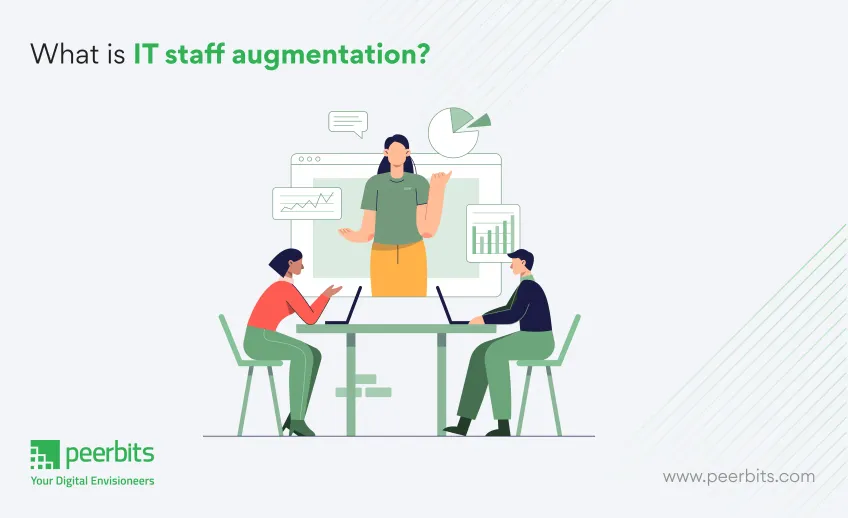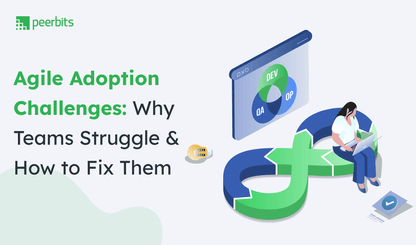Businesses are constantly launching new digital offerings like websites, apps, and software which demands staying on top of rapid technological advancements.
Surely global IT industry is growing phenomenally and also becoming competitive with more service providers. According to the Business Research Company, the IT market is expected to reach $13176.84 billion by 2029, with a compound annual growth rate (CAGR) of 8.2%.
This growth is fueled by factors such as increased personal computing, the mobile revolution, the rise of the internet, advancements in software development, the open-source movement, and growing cybersecurity concerns.
To meet the growing demands, companies often need to hire dedicated development teams but may lack the resources in-house. This is where they can turn to IT staff augmentation or managed IT services.
So, which model is better when comparing IT staff augmentation vs. managed IT services? There’s no universal answer. Each model has its own set of advantages, characteristics, and limitations.
As you read through this article, you’ll be able to determine the most suitable option for your business needs, without making premature financial decisions.
What is IT staff augmentation?

IT staff augmentation is a flexible outsourcing strategy that lets businesses hire skilled professionals as part of their recruiting process to supplement in-house teams. These external experts integrate smoothly into the organization’s workforce, helping complete projects or address skill gaps without requiring permanent hires.
This strategy is valuable for meeting short-term needs or when specialized expertise is critical, keeping projects on schedule without the need for long-term commitments.
Types of IT staff augmentation
IT staff augmentation offers various models to different business needs. From temporary support for short-term projects to hiring seasoned experts for leadership roles, these types ensure that organizations can address specific challenges and achieve their project goals efficiently.
1. Short-term staffing for temporary projects
This type focuses on hiring professionals for limited durations to address immediate project needs, such as development, testing, or deployment phases.
Short-term staffing is ideal for businesses managing seasonal spikes, urgent deadlines, or unique project milestones.
2. Long-term staffing for ongoing needs
When businesses face extended project timelines or require consistent expertise, long-term staffing provides reliable support.
These professionals become part of the team for several months or years, contributing to activities like software upgrades, system maintenance, or large-scale implementations.
3. Skill-based staffing for specific technologies or expertise
Projects often demand specialized skills, such as cloud computing, AI, or cybersecurity, that may not exist within the current workforce.
Skill-based staffing brings in experts with niche knowledge, ensuring the project's success while avoiding the need for permanent roles.
4. Staffing for leadership or highly experienced roles
Organizations sometimes require senior professionals, such as project managers, architects, or interim CTOs, to guide critical initiatives.
These seasoned experts provide strategic direction and ensure smooth execution during complex projects.
Advantages of IT staff augmentation
This model provides businesses with unparalleled flexibility, access to global talent, and cost-optimized solutions. Whether scaling dedicated development teams for a large project or hiring niche expertise, IT staff augmentation delivers practical benefits for businesses of all sizes.
1. Access to top-tier talent across global markets
Staff augmentation connects businesses with a global talent pool and let them find professionals with the exact skills needed for their projects.
This access to a diverse range of experts ensures that companies can meet even the most specialized requirements.
2. Flexibility to scale resources up or down as needed
Companies can adjust their team size based on project demands, hiring more professionals during peak phases and scaling down during quieter periods.
This flexibility helps businesses remain efficient and adaptable to changing workloads.
3. Full control over team dynamics and workflow
Augmented staff works directly under the client’s management, ensuring smooth integration into internal teams.
This helps businesses maintain oversight of processes, project priorities, and team collaboration.
4. Optimized operational costs for short-term needs
Hiring external professionals on a project basis eliminates the expenses associated with full-time hires, such as benefits, long-term salaries, or administrative overhead. This cost-effective model is beneficial for projects with defined scopes and durations.
Challenges of IT staff augmentation
While IT staff augmentation is highly versatile, it has its complexities. Organizations must navigate challenges like onboarding, knowledge gaps, and cost implications for extended periods to maximize its potential.
1. Requires time for onboarding and training
While augmented professionals bring expertise, they often require time to adapt to the company’s systems, tools, and workflows.
This onboarding phase can delay productivity in the initial stages.
2. Dependency on internal project management expertise
Effective utilization of augmented staff relies heavily on the organization’s ability to provide clear direction and manage the team efficiently.
A lack of project management skills can hinder the desired outcomes.
3. Potential for knowledge gaps regarding company-specific processes
External professionals might not be familiar with the intricacies of a company’s internal operations.
This can lead to miscommunication or delays in meeting specific project requirements.
4. Higher costs over extended periods
While cost-effective for short-term needs, prolonged use of augmented staff can become expensive.
This can make it less practical compared to hiring full-time employees for ongoing roles.
Best use cases for IT staff augmentation
IT staff augmentation is ideal for projects requiring temporary expertise, scalability, or specialized skills. It works best for businesses with clear project scopes and a need to enhance their team's capabilities without permanent hiring commitments.
1. Situations where short-term expertise or scalability is required
When businesses face fluctuating workloads or need extra hands for a limited time, staff augmentation offers the necessary scalability. Examples include managing seasonal demand, addressing skill shortages, or delivering specific project components.
2. Projects with well-defined scopes but insufficient in-house talent
Businesses with clear project requirements but a lack of internal expertise can benefit from this model. Developing a new feature, performing system migrations, or addressing technical gaps, staff augmentation helps achieve project goals efficiently.
What are managed services?

Managed services refer to the practice of outsourcing IT responsibilities to a third-party provider. The purpose is to offload tasks such as network management, cybersecurity, software support, and other IT operations.
Managed services focus on delivering complete, end-to-end solutions, ensuring that businesses can depend on a dedicated team of experts for continuous and efficient service delivery without internal resource strain.
Categories of managed IT services
Managed services encompass a variety of IT functions, each contributing to smooth business operations. Key categories include:
-
Network and infrastructure management: Ensuring the stability and performance of network systems, including servers, routers, and data storage.
-
Cybersecurity and threat monitoring: Protecting IT systems from security breaches, malware, and other cyber threats through constant monitoring and rapid response protocols.
-
Managed software as a service (SaaS): Outsourcing the management of software applications, ensuring updates, security, and performance monitoring are handled.
-
IT support and maintenance: Offering ongoing support, troubleshooting, and maintenance to address any IT-related issues promptly.
-
Data analytics and reporting services: Providing businesses with the tools to gather, analyze, and report data, supporting informed decision-making.
Advantages of managed services
Managed services provide several benefits to businesses, such as:
-
Around-the-clock availability for IT support and monitoring: Ensures that systems are continuously monitored and any issues are addressed promptly, minimizing downtime.
-
Predictable costs through fixed pricing models: Managed services often operate on a fixed-price contract, making it easier to budget and avoid unexpected expenses.
-
Proactive identification and resolution of potential issues: Providers anticipate problems before they arise, preventing system failures and ensuring smooth business operations.
-
Reduced dependency on internal resources: Outsourcing IT management frees up internal teams to focus on strategic projects, reducing the need for specialized in-house skills.
Challenges of managed services
While beneficial, managed services come with a few challenges:
-
Limited flexibility for project-specific customizations: Managed service providers may offer standardized solutions that are difficult to tailor for specific project needs.
-
Reduced control over certain IT operations: With third-party providers managing IT tasks, businesses may have less direct control over their systems and operations.
-
Security and confidentiality concerns with third-party vendors: Trusting a third party with sensitive data and systems can raise concerns about security and confidentiality.
-
Absence of physical on-site presence when needed: Many managed services are remote, which can be a limitation if on-site intervention is necessary for certain issues.
Best use cases for managed services
Managed services are ideal in the following scenarios:
-
Long-term IT maintenance and support requirements: Businesses that need ongoing IT support and maintenance without dedicating internal resources to these functions can greatly benefit from managed services.
-
Businesses needing complete outsourcing solutions for IT infrastructure or operations: Companies looking to outsource most or all of their IT functions, from cybersecurity to network management, can rely on managed services to meet their needs efficiently.
Comparing IT staff augmentation and managed services
Here is a table outlining the key differences between IT staff augmentation and managed services:
| Aspect | IT staff augmentation | Managed services |
|---|---|---|
| Control | More control over team, workflow, and decision-making. | Less direct control; the vendor manages IT operations. |
| Cost model | Pay-as-you-go; costs based on time and resources used. | Fixed fee structure; predictable costs over time. |
| Risk ownership | The client bears the risks (e.g., project delays). | The vendor assumes most of the risk in service delivery. |
| Scalability | Ideal for scaling teams with specialized skills for short-term needs. | Focuses on scaling IT operations, systems, and infrastructure. |
Choosing the right model for your business
When deciding between IT staff augmentation and managed services, several factors come into play:
-
Project duration: If the project is short-term or requires temporary expertise, staff augmentation is often the better choice. Managed services are better suited for long-term, ongoing IT management needs.
-
Budget: Staff augmentation can be more cost-effective for specific, temporary requirements, while managed services offer predictable costs for ongoing IT needs.
-
Skill requirements: For projects that demand specialized skills or a quick scaling of resources, IT staff augmentation offers flexibility. Managed services work well when the focus is on maintaining and scaling existing systems with less need for specialized knowledge.
-
Desired control levels: If a business wants more control over the team and project execution, staff augmentation is preferable. On the other hand, if a business prefers to delegate day-to-day IT operations to an expert provider, managed services would be a better fit.

A hybrid model: Combining staff augmentation and managed services
Businesses can gain substantial advantages by combining IT staff augmentation and offshore software development services with managed services. This hybrid model helps them to address immediate project-based needs while managing long-term IT operational requirements effectively.
Blending these models, organizations can benefit from the flexibility of augmenting their teams with specialized skills while utilizing offshore development services for routine IT management tasks through a trusted provider.
This lets businesses maintain control over short-term projects and resource allocation while ensuring their IT infrastructure remains well-supported and optimized.
Scenarios where this combination works well
This hybrid model is ideal for projects that require specialized skills for short-term tasks while ensuring ongoing IT support and infrastructure management for long-term operations.
Complex projects with specialized skill requirements
In scenarios where a project demands highly specialized skills or technical expertise, staff augmentation can provide the necessary talent. This could be for a product launch, a migration to new technologies, or any initiative requiring specific capabilities.
At the same time, managed services can handle the backend operations, such as server management, security monitoring, and general IT infrastructure, ensuring smooth day-to-day operations.
Scalable solutions for growing businesses
For a rapidly expanding company, staff augmentation can help quickly scale the workforce during peak periods, such as handling new customer demands or launching a new feature.
On the other hand, managed services can ensure that the company’s IT systems, such as cloud infrastructure and data storage, scale in parallel without the need for internal resources to manage them.
Long-term IT management with specialized expertise
A business that requires both ongoing IT support and occasional expertise for specific initiatives can greatly benefit from a hybrid model. Managed services can handle routine maintenance, monitoring, and operational issues, while staff augmentation can provide on-demand experts when needed for short-term projects or expertise gaps.
This hybrid model offers businesses the ability to be flexible, cost-effective, and efficient, as they combine the best of both worlds. It ensures the business can scale its workforce for specific needs while maintaining strong IT operations.
Steps to implement the right solution
Define requirements, identify needs, evaluate providers, and ensure smooth onboarding for effective implementation.
1. Define project requirements clearly, including budget and timeline
Start by outlining the specific needs of the project, including the skill sets required, the project’s scope, and any deadlines. Define your budget and timeline to guide the selection of the appropriate solution.
This clarity will help in choosing between IT staff augmentation or managed services based on project priorities.
2. Identify whether skill gaps or service gaps are the primary need
Evaluate if the project primarily requires additional expertise to fill skill gaps or if it needs a comprehensive service solution for ongoing IT management.
Staff augmentation is ideal for bridging skill gaps, while managed services are better suited for handling broader operational needs.
3. Evaluate providers for IT staff augmentation or managed services
Research and assess potential providers based on their track record, expertise, and compatibility with your project’s needs.
Consider the vendor’s reputation, service level agreements (SLAs), and their ability to scale as your business requirements evolve.
4. Onboard teams or establish processes for smooth collaboration
Once the right solution and provider are selected, onboard the IT staff or set up processes to integrate the managed cloud services into your operations.
Ensure clear communication channels and collaborative tools are in place to facilitate effective teamwork and service delivery.
Conclusion
Both IT staff augmentation and managed services have their advantages and drawbacks. Staff augmentation offers flexibility and control but requires more internal management, while managed services provide ongoing support with less involvement from your team.
It is important to assess your business’s specific needs, such as project requirements, budget, and desired level of control, before choosing the right option.
In many cases, a hybrid solution combining both models can be the best fit, providing the right expertise along with reliable IT support.

FAQs
Staff augmentation brings in expert IT specialists to work on a company's specific project. You will get the much-needed expertise required by contracting with a reputable company that offers on-demand access to IT specialists.
Here, a third-party company undertakes the entire project operations under its control. Most SMEs would exploit these subscription-based services to optimize their deliverables to the same level as industry leaders.
Often, businesses will have limited resource availability that lengthens the turnaround time. While employing permanent staff may get the job done, it increases expenses (hiring and training) even when they are not working on any project.
Managed Service Providers (MSPs) are outside companies that help businesses with their IT needs by handling support and upkeep. For this reason, modern businesses often see managed IT services as a quick fix to changing demands.
Staff augmentation services cost in India varies depending on your business requirements. Staff augmentation prices can be set based on the hourly rates of developers. Usually, this ranges from $25-$50 an hour. On the other hand, the cost of managed IT services will depend on the skills and expertise of developers. This can be paid hourly or assigned a project cost on a turnkey basis.








